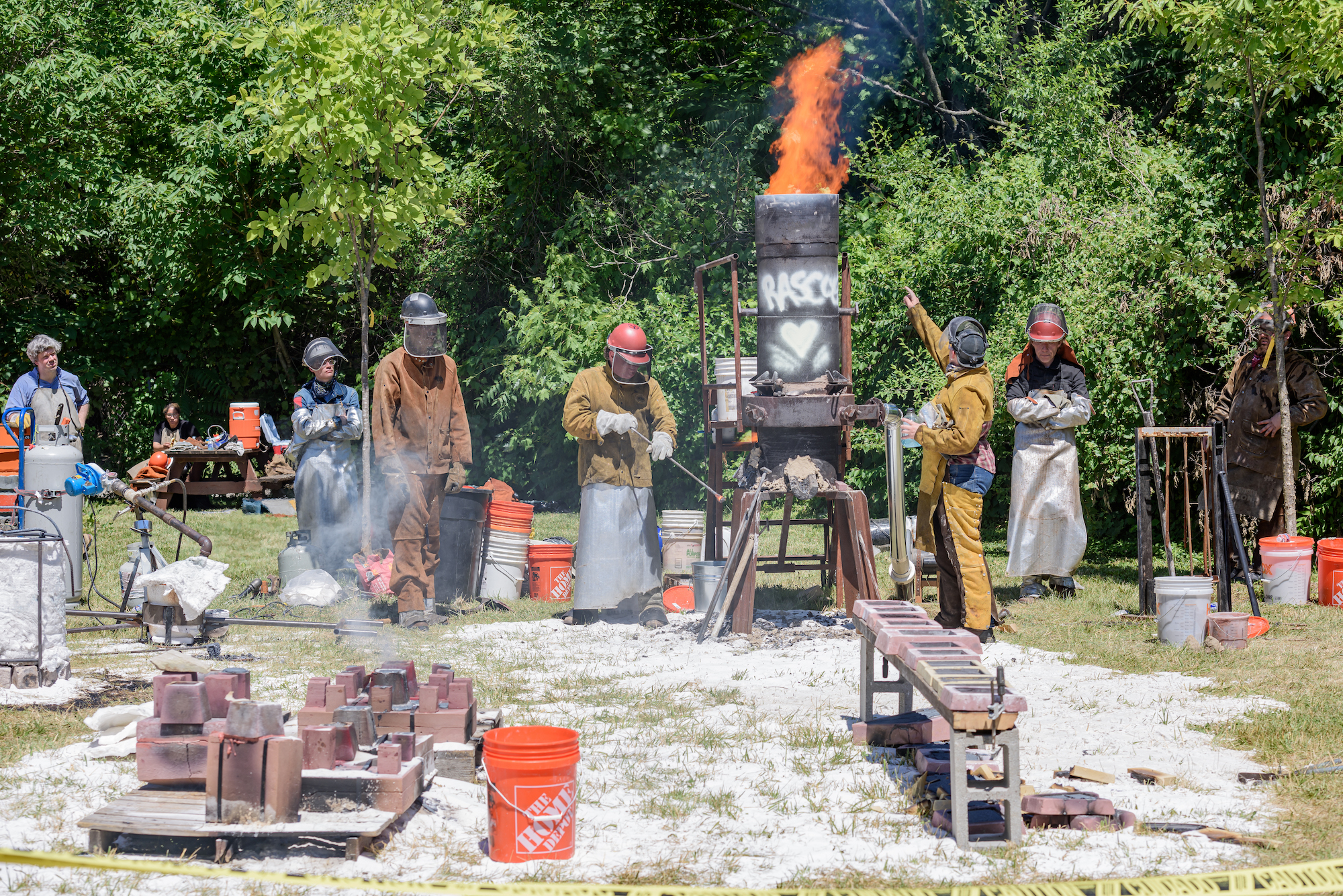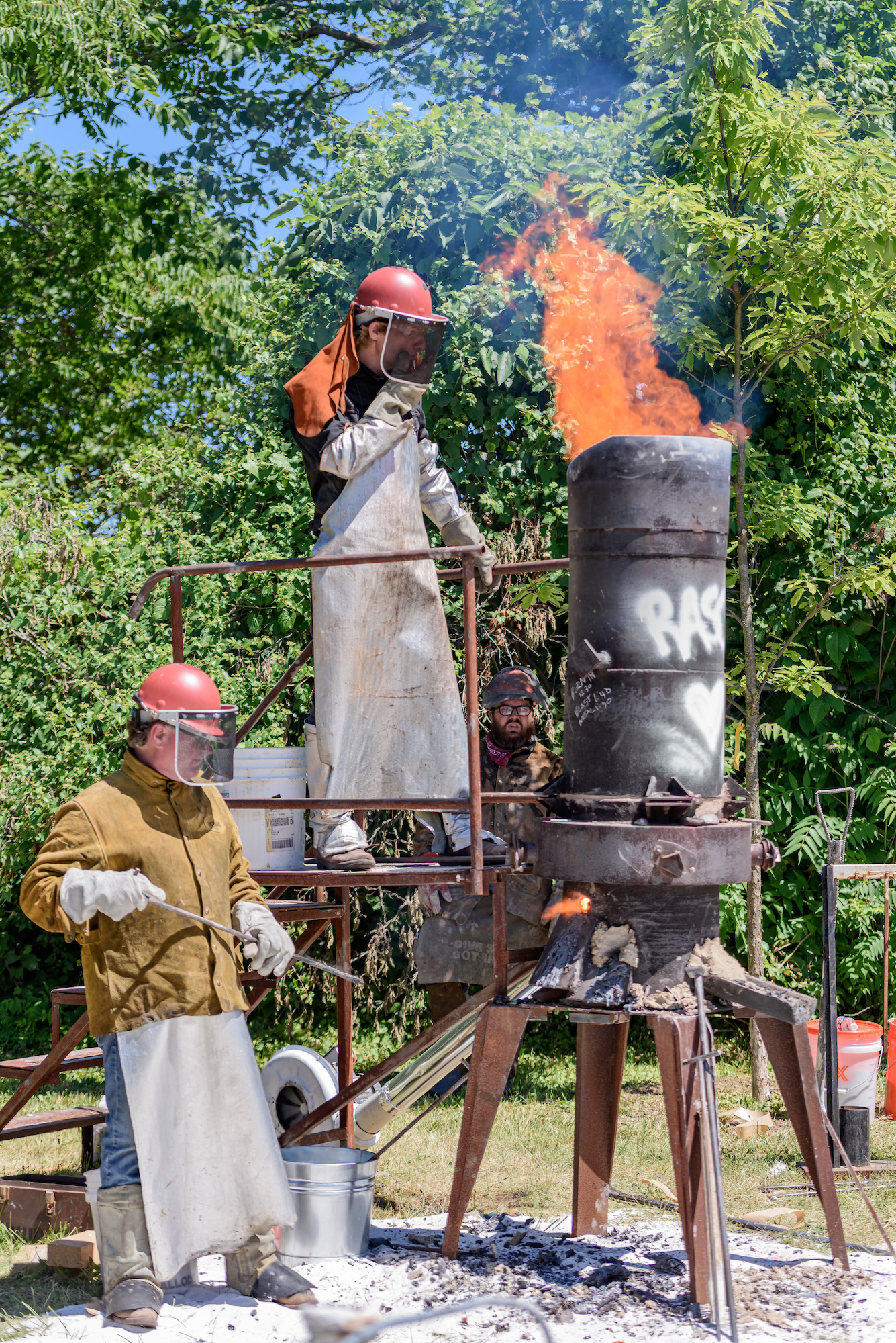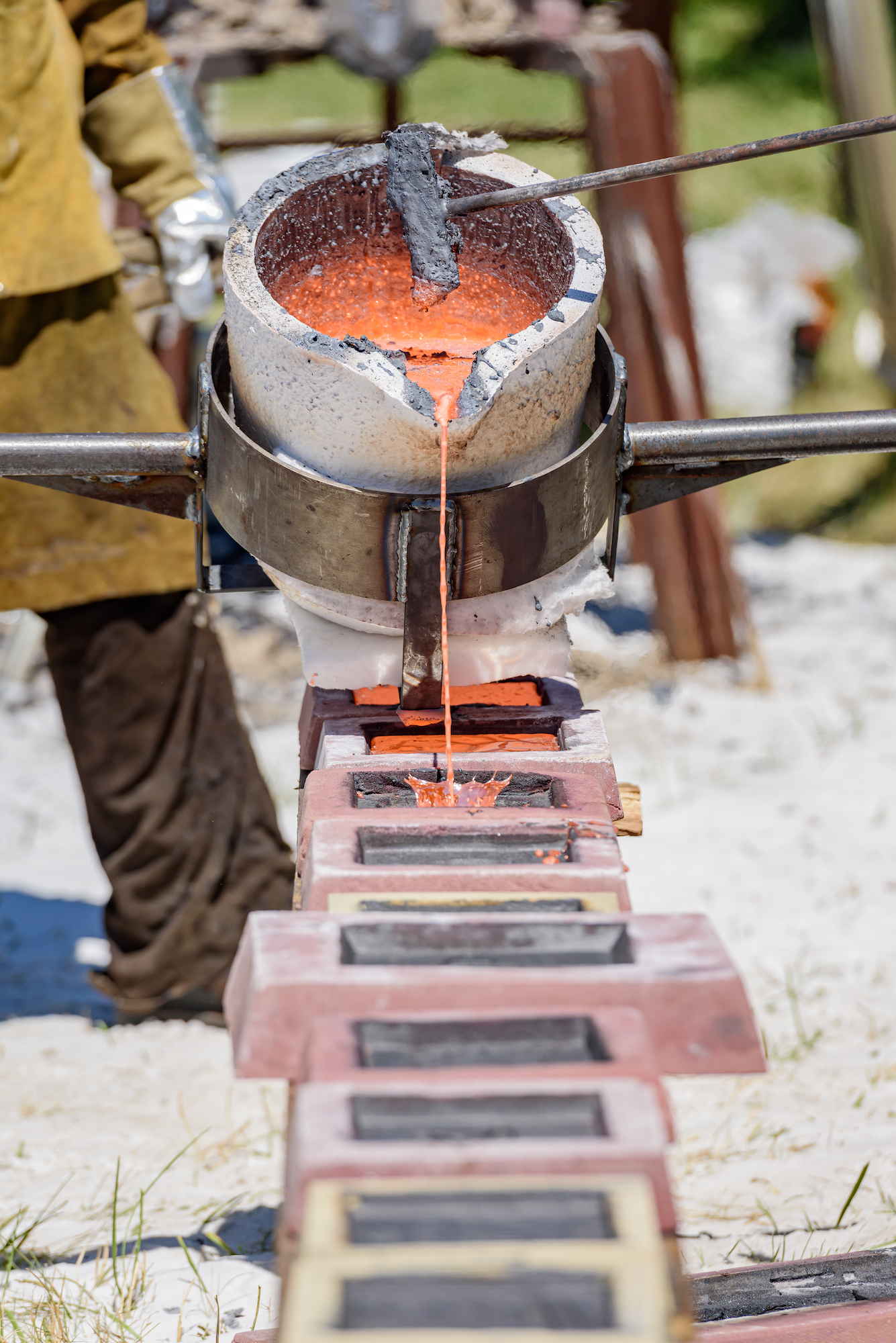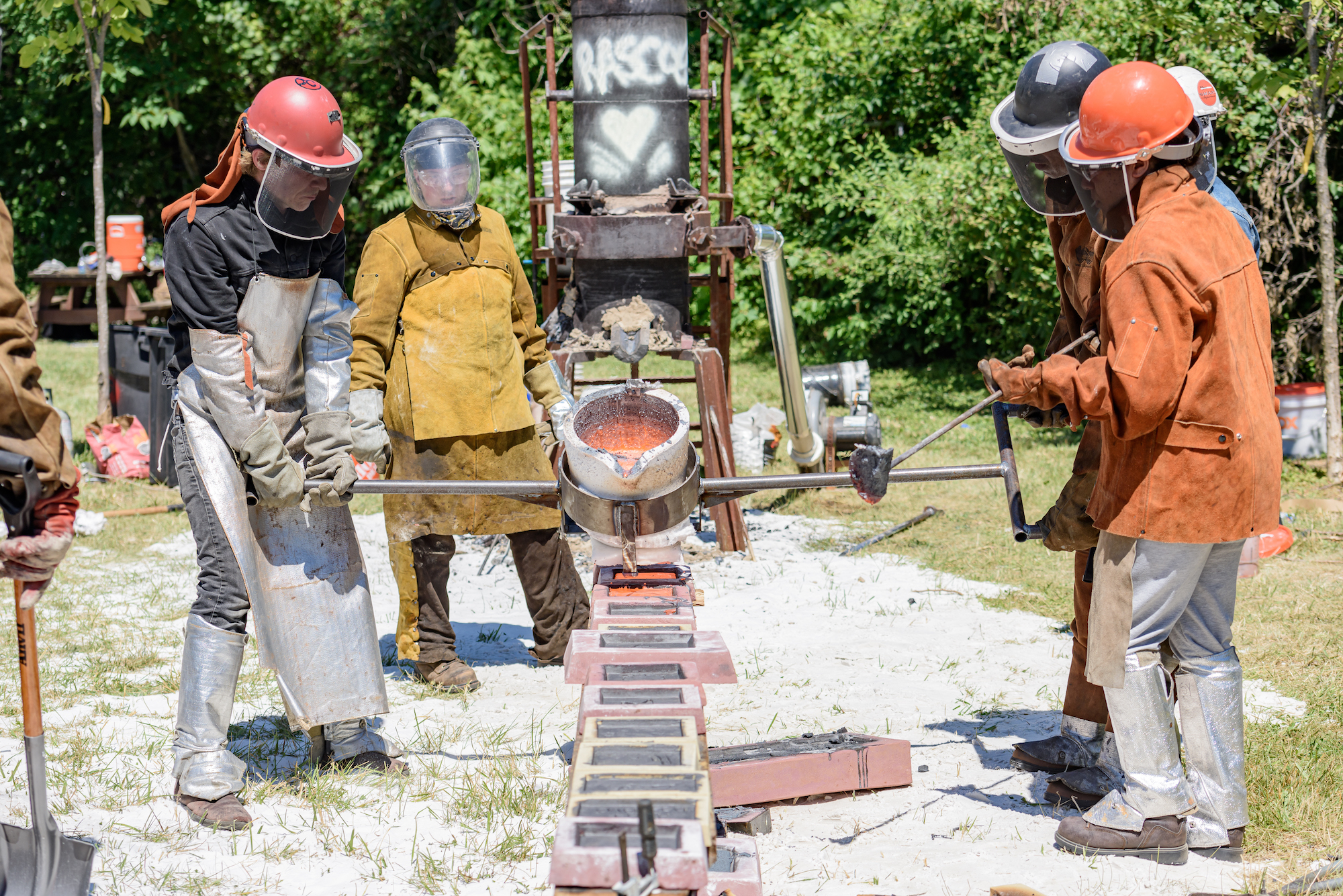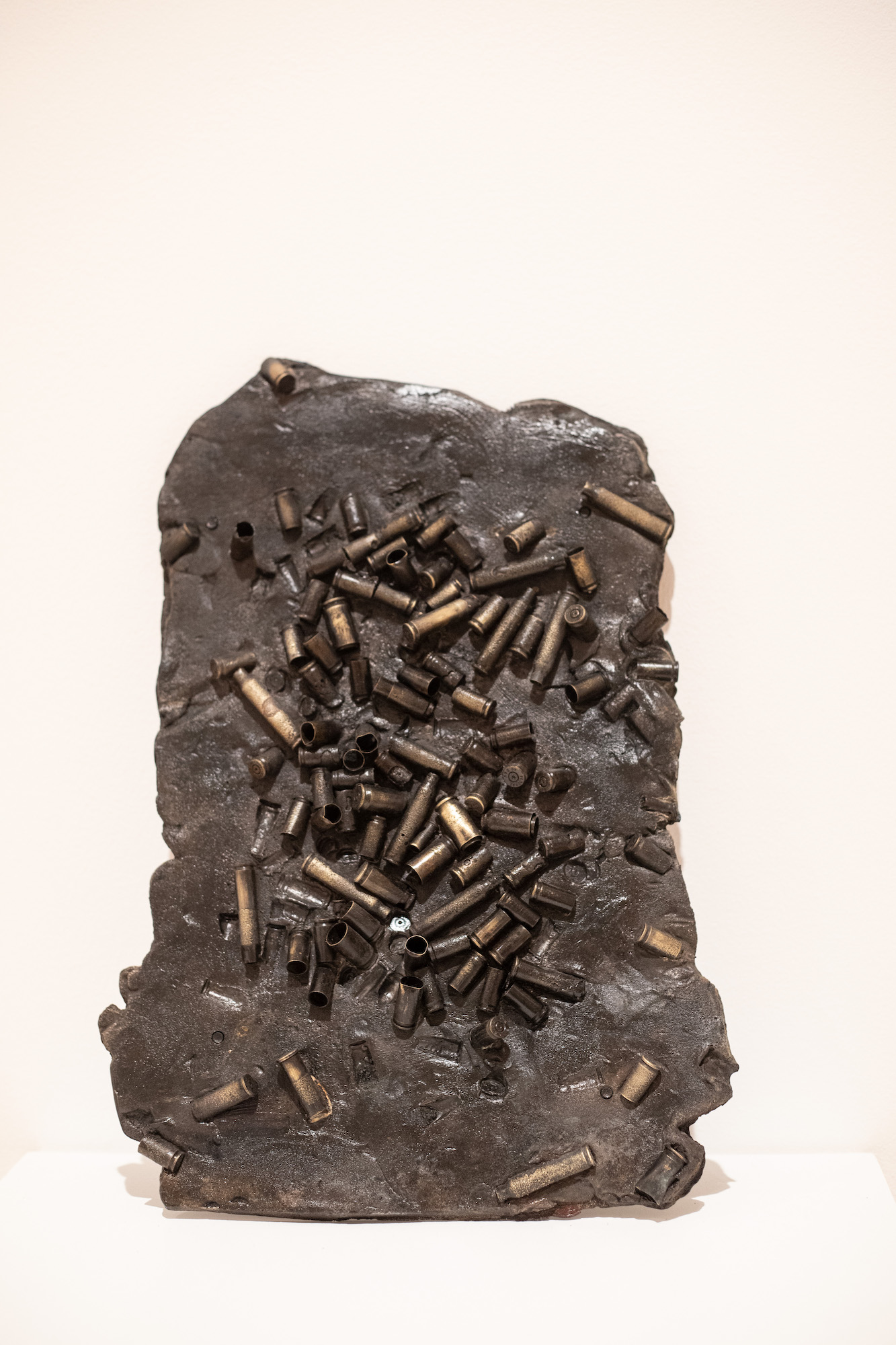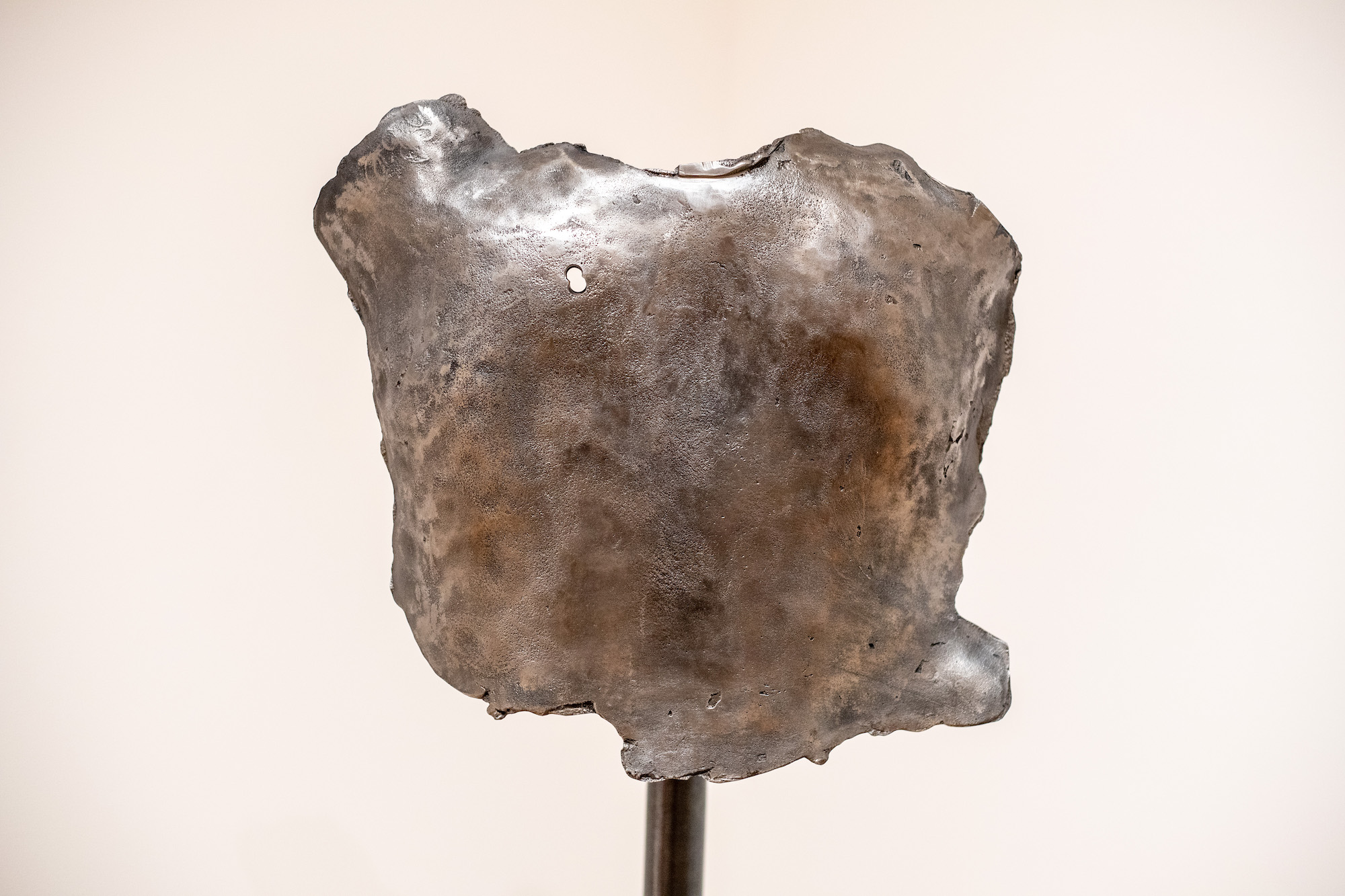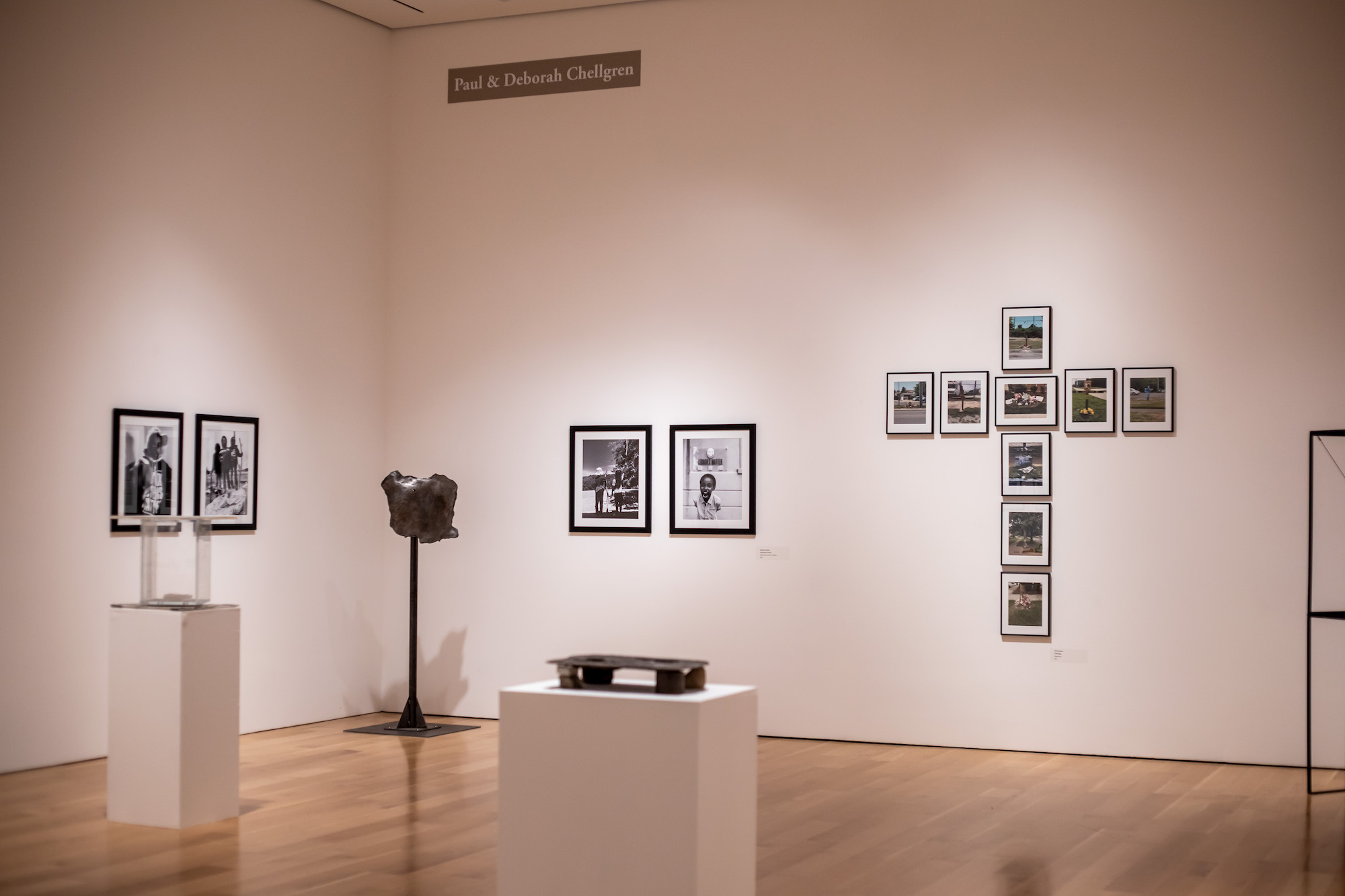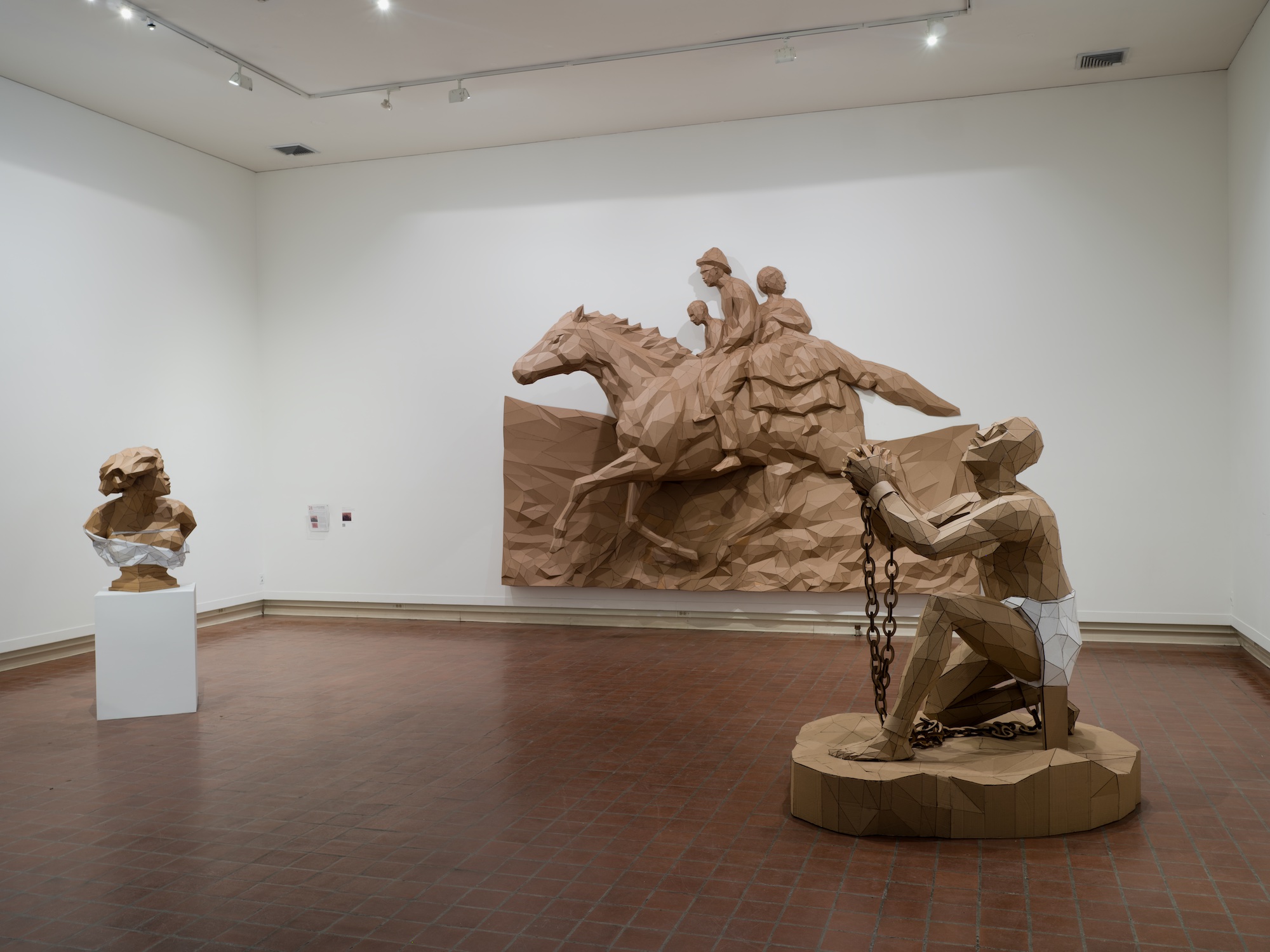Roberto Visani and The Promise
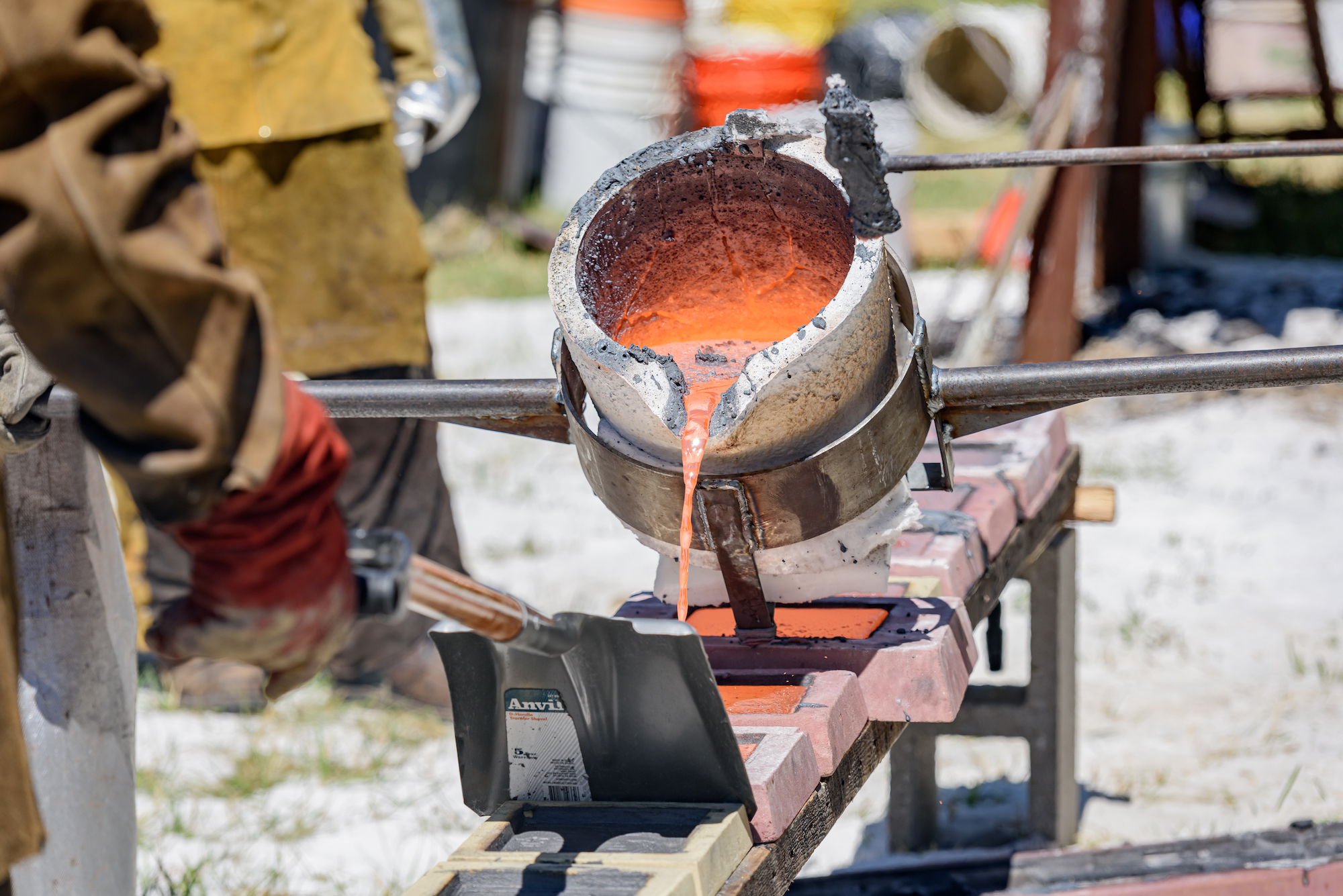
Share:
The heat wave had broken a day or so before, so having an iron pour in July in Louisville was a doable proposition. Iron pours are a collective activity centered around a ferocious-looking, rusty, cylindrical furnace that belches smoke and sporadically expels glowing red metal into crucibles that are lugged around by pairs of leather-clad folk: the tenor is part rockabilly with a touch of steampunk.
A varied assembly of artists gathered to make this event possible: Roberto Visani, a Brooklyn-based sculptor, coordinated the pour alongside Toya Northington—an administrator from the Speed Museum who put the event together as part of a program titled The Promise—and several workshop participants. Iron casters Calvin Hubbard and Hannah Hones drove from Boston and from Cortland, NY, respectively, bringing with them iron expertise and the furnace (called Rascoe) bolted to a trailer pulled behind Calvin’s Chevy Silverado. Matt Weir, Scott Boyer, and their staff at the Falls Art Foundry in Louisville’s Portland neighborhood provided the location and assistance. A lot of curiosity and a bit of bravery momentarily transformed what is often viewed as the domain of White hobbyists into a diverse project that managed to pull some of the more exciting aspects of iron pouring—adventure, spontaneity, and the production of permanent objects—into the consciousness of community members who had been touched by gun violence. Through the heat, fumes, and undertone of danger manifested a growing sense of justice and creativity, one that grew into something approaching, if not closure, at least healing. This idea of redemption through trial-by-fire is something that Visani has investigated in his career—approaching taboo objects and subjects such as guns and slavery, and creating poetic and lyrical interpretations that insist upon combining self-criticality with investigation. The exhibition of participants’ work produced during The Promise, including Visani and Northington’s workshop, opened at the Speed Museum on August 19, 2022.
Roberto Visani, The Promise, Iron Pour, 2022 [photo: Brian Bohannon; courtesy of the artist and Speed Art Museum, Louisville]
Visani is a chimeric artist: he is not only a maker—creating sculpture in iron, cardboard, and found objects—but he also teaches what art can do as a professor at the John Jay College of Criminal Justice. With The Promise he acted as a guide and healer, roles that are among the many hats that contemporary artists might wear. Visani is the son of a Trinidadian mother and an Italian father. He grew up hunting with his dad in South Dakota. His father didn’t shoot merely for sport, but used every part of the animal. “He would make leather jackets from the hides, and use the horns to make buttons,” Visani laughs. The artist’s first associations with guns were not connected to police or crime. He also spent a year in Ghana on a Fulbright grant (1997–1998), pursuing a personal calling to visit Africa, and the experience introduced him to a Black culture with a different interpretation of and response to colonialism, slavery, and White supremacy. His early gun sculptures were displayed at Jack Shainman Gallery in 2005 in the exhibition The Whole World is Rotten: Free Radicals and the Gold Coast Slave Castles of Paa Joe, curated by Claude Simard, and in 2005–2006 in Frequency at the Studio Museum in Harlem, curated by Thelma Golden and Christine Y. Kim. These works were polemical, beautiful objects that applied a Duchampian conceptualism to traditional West African DIY/found-object aesthetics. The guns are composed of constituent parts such as metal tubes and wooden scraps, but also bits and pieces of electronic components that embody a futuristic longing and aspiration for weaponized technology; video cameras and tripods are used to create ersatz weapons—also invoking the archaic hands-on tradition of making a gun oneself (Visani and his father created a black-powder gun from a mail-order kit when he was nine years old). A second project, exhibited in 2019 at The 8th Floor in Sedimentations: Assemblage as Social Repair, curated by Sara Reisman, consists of the silhouettes and relief topography of guns cast into rectangular iron plates. The plates depict the forms of firearms from a 2008 project of Visani’s that used weapons confiscated after their involvement in crimes and held in the storage facility of the Paterson, NJ, Police Department.
Roberto Visani, The Promise, Iron Pour, 2022 [photo: Brian Bohannon; courtesy of the artist and Speed Art Museum, Louisville]
Roberto Visani, The Promise, Iron Pour, 2022 [photo: Brian Bohannon; courtesy of the artist and Speed Art Museum, Louisville]
The gun sculptures were a distinctive, body of work, despite being intimidating to some viewers. Toya Northington, Interim Director of Education and Community Engagement Strategist at the Speed Museum, has followed Visani’s career for a while. “The Black art world is small” she said and added that it was “my dream” to have Visani lead The Promise, a workshop designed by the Speed to offer the local community a forum to address gun violence through art. Northington, an artist herself, helped coordinate the Speed’s groundbreaking Promise, Witness, Remembrance, a 2021 exhibition about the life of Breonna Taylor curated by Allison Glenn, brought about an unprecedented level of community involvement with the museum. This exhibition of works by contemporary artists such as Amy Sherald, Kerry James Marshall, Bethany Collins, and Alisha Wormsley included art related to the killing of Taylor by Louisville police. According to the museum’s description, “The exhibition explored the dualities between a personal, local story and the nation’s reflection on the promise, witness, and remembrance of too many Black lives lost to gun violence.”
Wanting to create a new identity for the museum in terms of community engagement, Northington designed The Promise: eight participants, pulled from the local Louisville populace, all having personally experienced gun violence, worked together, online and in person, for ten weeks. Visani, who saw The Promise as “a dream project,” collaborated regularly with the participants over the run of the workshop. “I was trying to avoid the teacher/student paradigm and the classroom paradigm throughout,” he says. Showing the participants artworks such as Gordon Parks’ The Atmosphere of Crime (1957), Pedro Reyes’ Imagine (2012) and Disarm (2013), Doris Salcedo’s Fragmentos (2018), Visani presented a variety of ways to communicate, unpack, and heal from the trauma of gun violence through artmaking. Northington felt that approaching gun trauma via art helps side-step the stigma that may accompany therapy or mental health treatment: “Art is much more accessible, people are more receptive to an art workshop—get them in the room and sparks typically fly if they’re open to it,” she said. “Art is the carrot to get people interested.”
Roberto Visani, The Promise, Iron Pour, 2022 [photo: Brian Bohannon; courtesy of the artist and Speed Art Museum, Louisville]
The eight participants were chosen by Northington based on very simple criteria: They needed to be African American, from the Louisville area, and to have been directly affected by gun violence. On the day of the iron pour, the participants sheltered from the hot sun under tents next to Falls Art Foundry. Participants discussed what had happened to them and how artistic practice could take many forms—as consistent protests or as a way of carrying on after tragedy.
Toya Northington , Charms, Curses & Crossings , 2022, Cast Iron and bullet casings [photo: Shantel Stubbs; courtesy of the artist and Speed Art Museum, Louisville]
One woman, Miss R., had been active in the Black Lives Matter marches and uprisings. She had lost two nieces to gun violence. For The Promise, she created a small “scratchblock” tile inscribed with the word Justice. J., a graduate student in the School of Public Health and Information Sciences at the University of Louisville, created his first ever work of art, a simple, rectangular iron plaque with the raised letters FAITH. Shauntrice Martin, who had been Community Connections artist-in-residence at the museum in winter of 2021–2022, paired a cast of her young son’s chest with a cast of a friend’s bullet-scarred back, creating medieval-looking torso armor. The slightly raised scar on the shoulder maintained its integrity as Martin first created an imprint in dental rubber, then in plaster, then in a sand mold, and finally in a thin iron shell—metaphorically tracing a permanent lineage of violence persisting and cycling through many iterations of artistic process.
Northington herself, who is a painter with a self-described foundation in Abstract Expressionism, took some of the spontaneity of action painting and generated a cast metal collage: empty gun casings appearing to melt and dissolve into a lugubrious form of iron. Northington was also closely touched by the death of a relative to gun violence, and her piece seemed to swallow up the refuse of the discharge of firearms into a kind of ferrous cloud of oblivion.
Shauntrice Martin, Lyokú (who remains), 2022, Digital prints & Cast Iron sculpture (detail image) [photo: Shantel Stubbs; courtesy of the artist and Speed Art Museum, Louisville]
Not all participants in The Promise chose to cast in iron—others created videos, soundpieces and photo essays—but most were present for the iron pouring. Their deep sense of participation in the workshop was emphasized in the discussion that followed.
Visani divides his production into three categories, each of which combines a novel aesthetic with a different political message. Two were on view at the Speed Museum: “Improvised Weapons,”the guns; and “Primary Structures,” figurative sculptures that appropriate the formal aesthetics of Dogon sculpture from Mali. For this latter series, Visani digitizes the devotional forms and renders them in a tessellated format. Much like his imprinted and found-object guns, these works employ a very simple and direct object-generating practicality. Visani is able to standardize the sculptures and distance them slightly from their wooden originals. He likes that the distinctive hands-up gesture in the Dogon pieces is theorized to be a ritual summoning of rain, placing the body in a position formally identical to that demanded by the police of a suspect and the corresponding gesture of defiance at Black Lives Matters marches throughout 2020 after the murder of George Floyd by police in Minneapolis. Over the last five years Visani has been transforming the hands-up figures into permanent iron forms.
Roberto Visani , Installation view of several sculptures from the Hands Up series, 2020, cardboard and hot glue [courtesy of the artist]
A few days before the iron pour, the participants gathered in a gallery of the museum, on the second floor of the new addition, designed by Kulapat Yantrasast of WHY architects. Many were already familiar with the Promise, Witness, Remembrance exhibition, and they felt a certain awe upon seeing their work in an institution, an example of giving back to the community that Northington feels is necessary for contemporary arts venues.
The Promise, installation view, 2022 [photo: Shantel Stubbs; courtesy of the artist and Speed Art Museum, Louisville]
At the Brattleboro Museum, in Visani’s first solo museum exhibition last spring, entitled Form/Reform, Visani exhibited his third distinct series of sculpture, his “Cardboard Slave Kits.” These epitomize his practice—they incorporate teaching, group participation, as well as his own vision and interpretation of art history; he sees them as an embodiment of Beuysian social sculpture. Like the guns, the “Cardboard Slave Kits” pull from an historical body of work that offers disparate and divisive readings—18th and 19th century White European and American sculptors who made these works for the purpose of promoting the abolitionist cause—such as Jean-Baptiste Carpeaux (1827–1875), Josiah Wedgwood (1730–1795), and Hiram Powers (1805–1873). They also have some of the dark humor of Zbigniew Libera’s Lego Concentration Camps, employing a hobbyist/toy technology to reference problematic issues. The enslaved figures in the sculptures by Wedgewood and Powers are purposefully subservient, sometimes even desperate. At the time, the kneeling, or pleading/grateful slavewas a genre/format knowingly devised by the sculptors to appeal to a public who might have been indifferent and even alienated by the imagery of empowered and free Black people. Through contemporary eyes, though, the figures seem dated and unnecessarily abject. But certain of the sculptures, most notably Wedgewood’s Am I not a man and a brother (c.1787), were widely reproduced by many different artisans (Wedgewood had wanted the image to be what we would now call open source). The figure of the kneeling and pleading enslaved man offers a dual, contradictory reading that Visani enjoys: Wedgewood’s man is on one knee, which Visani links to Colin Kaepernick’s defiant “taking a knee” during the playing of the National Anthem. Further, Visani declares, unironically, that these works are a combination of studio, sculpture, classroom and gift shop, a wide creative landscape that, not unlike The Promise, can involve almost anyone.
Roberto Visani , Form/ Reform, installation view, 2022 [courtesy of the artist and Brattleboro Museum, Brattleboro, VT]
Traditionally, artists have been employed as across-the-board makers and coordinators of culture. Their responsibilities became more codified as art objects themselves became more commodified. The iron pour that marked the fulfillment of The Promise fit very neatly into everyone’s goals for the project—for Visani, the exhibition and the iron pour were an extension of his art. “Normally I think about my work engaging the audience in a more passive way,” Visani says, “but in this project the audience became the work and the work became the audience.” For Northington, The Promise was an opportunity for the Speed Museum to show the local community that the artistic impulse can be about “flattening hierarchy and privilege.”and both “celebrating and honoring the experiences of [victims of gun violence], not just staying in the moment of grief, but also how can we build something impactful from it?” “Healing comes in a lot of different ways,” she added.
Will Corwin is a sculptor and journalist from New York. He has exhibited at Clocktower, La MaMa Galleria, and Geary gallery in New York, as well as in London, Hamburg, Beijing, and Taipei. He writes regularly for ART PAPERS, The Brooklyn Rail, BOMB, artcritical, and Canvas—and formerly for Frieze.
